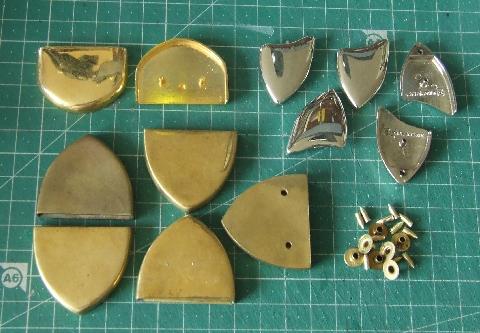-
Posts
5,928 -
Joined
Content Type
Profiles
Forums
Events
Blogs
Gallery
Everything posted by fredk
-
Chestnut dye can be got. Try your russet on a scrap piece first to see if you like it. It might be a bit too red
-
But . . . . but . . . . . hows anyone gonna knows whoms is 'Cactus Jack' !
-
yes, you can, actually better than those cheap eyelet pliers For your use I think grommets would be better. The grip side of the eyelet usually splits and can have small sharp edges whereas the grommet does not
-
Getting there. I'd still make the cactus cartouche longer with a bit more area between the cactus and the edge of the cartouche, especially at the top. When you cut the border its going to make the top of the cactus looked cramped. In art, things/people need a space to go 'into'; your cactus needs more space at the top above it for it to 'grow' into.
-
Mix up some 'saddle soap' and apply that to the hide, or just some neetsfoot oil on its own. Not too much, apply some by brush or sponge, allow that to soak in for a day or so, and repeat. But keep checking it. Never too much nfo. Just enough to get that hide softened and supple. It may work, but be prepared that it may not
-
as far as I can see the inner edges of the two cartouche with the cactus will be lost around the bend and they'll look bad. Do you really need a full design on the back? I think, you should get rid of the rear cartouche and have the main design fade away to nothing just beyond the bend, about 1/3 through the belt loop position [from the bend]. Move the front cartouche more to the edge and thin it and elongate it; overlap that upper leaf and lower flower petal; like its a concho applied over them. I'd move that border line along the edge closer to the edge. A few mm or bits of an inch can make a big difference
-
I just place my stamp on the leather and bring the ram down to press the stamp into the leather.
-
Which book? Which section? If you give me that info I could suggest an alternative way of working
-
but thanks for the offering anyways
- 10 replies
-
- karlova
- free patterns
-
(and 1 more)
Tagged with:
-
If you have a press you don't need to heat the stamp for veg tan. Depending on the veg tan sometimes you don't even need to case the leather. I've even been able to impress my maker stamp and certain other stamps in thick chrome tan using my press
-
as per title [we don't seem to have a 'Free' section] A selection of belt tips as in the photo. I think they are all brass based. The two top left, for 35mm strap, 'gilt' plated, top right, 5 'chrome'? plated, for 20mm strap and the bottom 5 are plain brass for 35mm strap, and a few fixings for these FREE in the UK including free delivery [for now] Please PM me an address I can post these to if you're interested I plan to put up some more odd hardware, including some pressed steel two-slot conchos and some belt ornaments But that's in the future, so stay tuned, don't change the channel
-
When I want a ready rivet to sit flush I just give it a good hard whack on my anvil. It buries itself in the leather. If using ready rivets, use double headed ones. I've found that the base of a single head r/r can split and leave sharp edges. Doesn't happen with double headed ones, they give a smooth surface on both sides of the project
-
The choil is on the edged side of the blade not the back The back side notches are derived from older knives where the notches were deeper. They were called blade breakers. In double handed sword/knife fighting, called ;main gauche' fighting the knife is used defensively and you try to catch your opponents sword or knife in one of those notches and if you are skilled or just plain lucky a twist of your knife with the captured blade will break that blade [ I broke a few good sword blades in some fights doing this ] More modern knives have more shallower notches which are often slightly sharp and they can be used for de-scaling fish, cleaning fat off the meat or skin of killed prey/food or even as a saw for cutting fire wood
-
Not many 'ceegar' stores in UK anymore. I'd say there are extremely few. No-one smokes ceegars anymore here. There is only one store in N.I., in Belfast
-
I just glue thin lining leather, about 0.5mm to 1mm thickness, to the main leather and sew it all up as one thickness
-
Back to the title subject; McD are selling up and ceasing business in Russia https://www.bbc.co.uk/news/business-61463876 Renault cars has already left Just a few companies now but maybe the start of a flood?
-
Others will have far better advice on this cos I've never made a holster. I've just been reading up on how to make a Slim Jim and the advice is to glue the liner on with the outside leather curved. If you do it this way it would be awkward to cut and tool the outside, it would be easier if you do the tooling first then glue in the lining
-
That is a 4-prong/tooth set of stitching hole pliers. I have these 4 prong and set with 2 prongs. You can go around a project and punch stitching holes in it very quickly and very quietly Limits to them are; you can't go any further in tan about 20mm and the hole size and distance gap is set You can also get ones with a larger prong for making lacing holes
-
For 'seeds' you can use regular nail setters. They usually come in sets of 3 different sizes. The end of certain types has a circular depression in it which makes a good 'seed' or 'period/full stop' in lettering
-
yes, I've bought, actually 16 of them for a project, at £0.95 each. = $1.17 approx. Another shop has them at £1 each, = $1.23 approx Yes they are decent hammers, light weight, about 10 oz
-
Your carving and tooling is pure artistry
-
Your carving and tooling is pure artistry
-
Even they are immigrants, the first of many, about 17,000 - 16,000 years ago! Very little is made of this. During the 'Highland Clearances' from about 1680 to 1850 tens of thousands of Scots were forcibly sent to the Americas [ all of the American continent, Welsh were sent to South America ] mostly as 'indentured' servants. Several thousand never survived the sea journey. The ships used were on their last journey, The Scotch land owners chose cheap ships for the job. Upon arrival in the Americas the slaves were to be sold and the ship broken up and sold as scrap. These ships were small, about 120 ft long at the water line and 40 ft wide at the beam. Hundreds of people were crammed on to them - in the same manner the black-man was transported My home town participated in this slave trade. The town was a major sea port back then and ships from Scotland called in for fresh provisions before making the Atlantic crossing. It was chosen for this as the land owner and harbour owner was Scotch and was involved in the 'clearances' himself. The people of this town saved at least 1700 people on one occasion. The ships used to just stop and anchor off-shore. But on this occasion a terrible big storm came up, the 3 ships were beached and the slaves taken off and housed in local farmers barns until the storm passed. Over the next 4 days 1700 people, all the slaves, 'disappeared' ! The local magistrate fined the local people for the 'loss of the cargo due to not securing the barns', but as the barns were actually owned by the local land lord he had to pay the fine to himself ! And these 'indentured' slaves got their own back - the Scotch and Irish were present in great numbers in George Washington's Continental Army which beat the pants off the British in the AWI [1775 - 1783]




